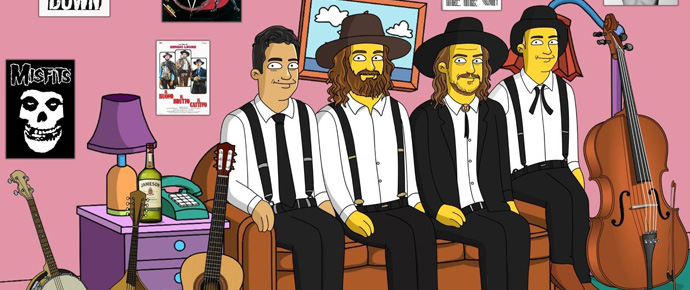The Dead South has helped make bluegrass a viable genre in Canada. Canadians always liked traditional music and American folk, but it was the success of The Dead South that brought mainstream attention to bluegrass. The video for their song – In Hell I’ll Be in Good Company – posted in 2014, has gotten more than 227 million views. The population of Canada is just shy of 38 million, so the number is impressive. Nate Hilts, one of the band’s founding members, is still amazed by the song’s success.
“We don’t have the statistics, but it’s viewed by people from all over the world,” he said. “I guess a lot of people play it over and over. We had no idea the video would be anything special. We just came up with an idea to stand there and sing the song in a bunch of different locations and it caught on.”
The video shows the quartet in their trademark outfits, white shirts with black pants and black suspenders. The background shifts rapidly between record stores, rooftops, city streets, living rooms, meadows, breweries and other locations, while the band sings, plays and dances in place. Hilts wore a wide brimmed hat that made the quartet look a bit like Amish farmers. “We got the clothes from thrift stores,” Hilts said. “It was our usual stage costumes. There was no particular desire to look Amish. It was just a natural progression that slowly evolved and took on a life of its own.”
The band is based in Regina, Saskatchewan, and plays bluegrass on acoustic instruments, but critics have noted that they play with a punk rock, almost heavy metal approach, and tempos approaching the supersonic. “We love bluegrass, but our style stems from all sorts of music,” Hilts said. “Punk and metal and classical make their way in. Our cellist, Danny (Kenyon) holds his instrument like a guitar and plays it like a stand up bass. The speed comes from playing together for years. We didn’t do it consciously, we just started playing faster and faster.”
“I like country from the ’50s and ’60s, old time music, Neil Diamond, Meatloaf, The Doors, Led Zep, Pearl Jam… I’ve always been that way. I started playing acoustic when I was young and stuck with it. I like the idea of being able to pull out a guitar anywhere I am and play. It suited me. I had no idea how to sing when we started the band. I was listening to The Steel Drivers and looking for a middle ground between bluegrass and rock. I didn’t have the voice to sing traditional bluegrass, so I did what I could. That may be why we sound a bit rock and roll. We don’t take ourselves too seriously, but we understand how impressive good bluegrass players, are and how awesome the music is.”
“For the past few years, we’ve been touring for three weeks, then taking three weeks off. We play in Canada, Europe, and the US. We’ve been building a following in The States for the past three years, playing a lot of festivals. We just came back from the UK and were getting ready to play at the Junos (Canada’s Grammy equivalent) when the virus hit. At first, it was great to be home. I could eat healthy and relax, but you’re stuck in one place, literally. I’m doing a little bit of recording at home and working on perfecting my singing and guitar skills.”
On that last tour, the band recorded every show so after the shut down, they decided to put together a live album.
“The original idea was just to be able to listen back and hear how we sound. We play every night and get feedback from people at the shows, but we didn’t know what we sounded like. Those recordings evolved into an album. Since no live shows were happening, it seemed like a good idea to put them together and release a live record. It was put together after the lockdown. We took 17 tracks from 17 different venues and cities.”
The result is Served Live, a set of the band’s crowd favorites. The record is accompanied by a video fans created for The Recap, one of the album’s most energetic tracks. “The audio is from the live recording on the album. The shots are fan footage from anyone who was at a show, or backstage during a show. We asked everyone to send in what they had. We all got together [cellist Danny Kenyon; banjo player Colton Crawford; guitarist and mandolin player Scott Pringle] to decide what to use and put it together. It was pretty nice to watch. Our live sound engineer, Kyle Halvorson mixed it up and our manager, Chris Wynters, sorted everything out and put the album together.”
Served Live is a generous collection, an hour and a half of vigorous picking and playing. Hilts said the album shows off the band at its best. “It showcases the way we work. We have a good bond with each other. Our motto is, ‘Friends first, then a band, then a business.’ We’re not afraid to share ideas and arrangements and let someone know if an idea stinks. We work really hard and, when we’re not locked down, we’re on the road for most of the year.”
